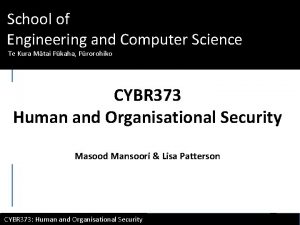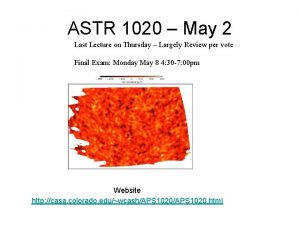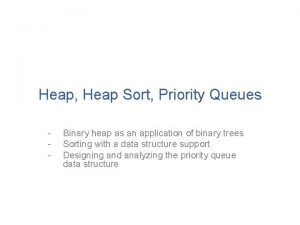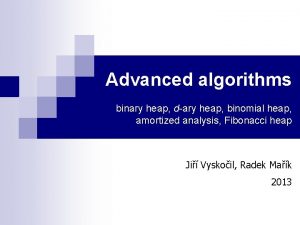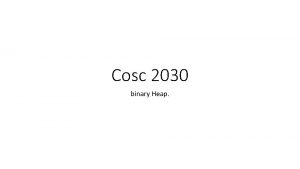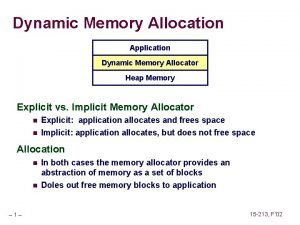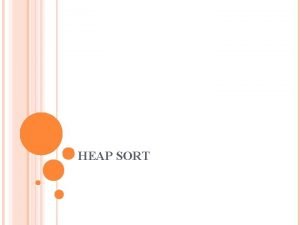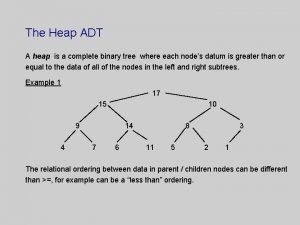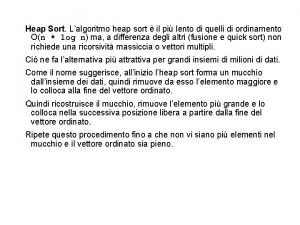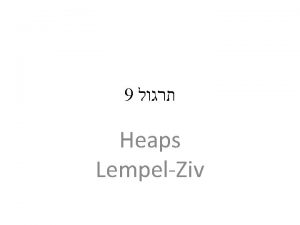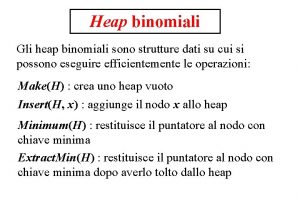FREEGUARD A Faster Secure Heap Allocator Sam Silvestro























- Slides: 23

FREEGUARD: A Faster Secure Heap Allocator Sam Silvestro, Hongyu Liu, Corey Crosser, Zhiqiang Lin*, Tongping Liu University of Texas at San Antonio * University of Texas at Dallas

Memory Security of C/C++ Programs • Stack security • Heap security 2/25/2021 The University of Texas at San Antonio, One UTSA Circle, San Antonio, TX 78249 2

Memory Security of C/C++ Programs • Stack security • Heap security 2/25/2021 The University of Texas at San Antonio, One UTSA Circle, San Antonio, TX 78249 3

Common Heap Vulnerabilities • Buffer over-read – Information leakage • e. g. , Heartbleed • Use-after-free • Buffer overflow • Double / invalid free – Unexpected results, program crash, hijacked control flow 2/25/2021 The University of Texas at San Antonio, One UTSA Circle, San Antonio, TX 78249 4

Heap Vulnerabilities Reported in NIST Database Heap Vulnerabilities Heap Over-reads Heap Over-writes Occurrences (#) Use-after-frees Invalid-frees Double-frees 264 35 33 125 673 Many vulnerabilities were reported just in the past yea 2/25/2021 The University of Texas at San Antonio, One UTSA Circle, San Antonio, TX 78249 5

Defending Heap Vulnerabilities • Detect bugs with automated tools, e. g. coverity, asan – Overhead issue, completeness, false positives • Rewrite code using a safer language, e. g. java – Huge amount of effort and performance issue • Prevent code execution – Can’t handle return-to-libc or ROP attack • Sanity check on execution flow, e. g. CFI – Balance between performance and effectiveness • Increase the difficulty of attacks, e. g. 2/25/2021 The University of Texas at San Antonio, One UTSA Circle, San Antonio, TX 78249 6

Defending Heap Vulnerabilities • Detect bugs with automated tools, e. g. coverity, asan – Overhead issue, completeness, false positives • Rewrite code using a safer language, e. g. java – Huge amount of effort and performance issue • Prevent code execution – Can’t handle return-to-libc or ROP attack • Sanity check on execution flow, e. g. CFI – Balance between performance and effectiveness • Increase the difficulty of attacks, e. g. 2/25/2021 The University of Texas at San Antonio, One UTSA Circle, San Antonio, TX 78249 7

Default Linux Allocator • Designed to perform well malloc_sta te – Bump pointers + freelists – Not designed for security purposes ⋮ top • Prepends metadata before actual objects • Provides no randomization ⋮ – Result: easy to determine next object to be allocated • Poor handling of double/invalid frees unused allocate d header free header Heap segment prev size 16 cur size 32 allocated space prev size cur size free space �������� �� ����� 32 24 �� fd bk An example of Linux allocator’s object metadata placement 2/25/2021 The University of Texas at San Antonio, One UTSA Circle, San Antonio, TX 78249 8

Existing Secure Allocators: Open. BSD and Die. Harder • Both are BIBOP-style secure allocators – “Big Bag of Pages” – Each “bag” of pages holds objects of a specific size class • Both feature randomization related with each size class – Die. Harder = log n bits of entropy – Open. BSD = 2 ~ 10 bits • Both impose high performance overhead – Evaluated runtime overhead: • Open. BSD ≈ 34% • Die. Harder ≈ 88%, up to 10 X – Use bitmaps – Utilize large number of system calls (mmap) – Use the same heap for different threads • May result in significant performance loss for dominant multithreaded apps 2/25/2021 The University of Texas at San Antonio, One UTSA Circle, San Antonio, TX 78249 9

Motivation of Free. Guard Die. Harder Security Open. BSD Free. Guard 2 1 3 4 Linux Performance • Performance-oriented allocators are not secure • Secure allocators are too slow 2/25/2021 The University of Texas at San Antonio, One UTSA Circle, San Antonio, TX 78249 10

FREEGUARD’s BIBOP-style Layout • Acquire large block and divide into multiple heaps • Per-thread sub-heap design • Sub-heaps made up of 16 bags • All bags have same size • Each bag serves a specific size class • Size classes increase by powers-of-two 2/25/2021 The University of Texas at San Antonio, One UTSA Circle, San Antonio, TX 78249 11

FREEGUARD’s BIBOP-style Layout • When one heap is exhausted, the thread utilizes the bag (with the same index) in the next heap • Uniform layout: – Bags have same size – Same number of bags per sub-heap – Same number of subheaps per heap – All quantities are powers of two 2/25/2021 The University of Texas at San Antonio, One UTSA Circle, San Antonio, TX 78249 12

FREEGUARD’s BIBOP-style Layout • Informationcomputable – Given an address: • • Size class Owning thread Starting address Metadata location – Enables constant-time deallocation – Detects all double and invalid frees 2/25/2021 The University of Texas at San Antonio, One UTSA Circle, San Antonio, TX 78249 13

Freelist-based Design • Linked-list maintains deallocated objects • Enables constant-time allocation HEAD Freelist : 1 2 3 4 TAIL • Together, with information-computable layout: 2/25/2021 The University of Texas at San Antonio, One UTSA Circle, San Antonio, TX 78249 14

Summary of Performance Improvements • Unique information-computable design – BIBOP-style layout with metadata in shadow memory • Constant-time allocation and deallocation • Per-thread sub-heap design reduces lock contention • Reduced number of system calls 2/25/2021 The University of Texas at San Antonio, One UTSA Circle, San Antonio, TX 78249 15

Secure Design – Segregated Metadata • BIBOP style can separate metadata with the actual heap • Metadata is placed in a separate area, preventing metadata-based attacks Linux Allocator 2/25/2021 prev size 16 cur size 32 allocated space prev size 32 cur size free space ���� �� ���� 24�� bk fd The University of Texas at San Antonio, One UTSA Circle, San Antonio, TX 78249 16

Secure Design – Randomization • Four-way randomization: increase attack complexity – Each per-thread/per-bag pair has 4 freelists & 4 bump pointers – On allocation, choose one-of-four freelists and possibly from bump pointers – If empty, use the bump pointer with the same index – Some chance we fall back to bump pointer, even if freelist is nonrand() = 14 empty Heap 0 Heap 1 Heap 2 Heap 3 Metadata: Heap Data: Freelist 0 Bump Ptr 0 Freelist 1 Bump Ptr 1 Freelist 2 Freelist 3 2/25/2021 14 MOD 4 = 2 Bump Ptr 3 The University of Texas at San Antonio, One UTSA Circle, San Antonio, TX 78249 17

Secure Design – Guard Pages • Guard pages have all permission bits turned off • Static guard pages – Placed at end of every bag • Random guard pages – Distributed throughout bag – Default proportion: 10% of each bag – Helps prevent heap spraying, buffer overflow attacks Randomized Guard Pages Static Guard Pages �� Allocate d Free Guard Page SEGFAULT Bag n 2/25/2021 Bag n+1 The University of Texas at San Antonio, One UTSA Circle, San Antonio, TX 78249 18

Secure Design – Canaries • Canary values with neighbor checking – Checks canary values of freed object’s neighbors – Helps the timely detection of overflows – Skips neighbor if not in-use or inside guard pages Free ( ) Heap objects: Guard Page Check 2/25/2021 No Check The University of Texas at San Antonio, One UTSA Circle, San Antonio, TX 78249 19

Handling Large Objects • Objects >512 KB classified as large objects – Allocated separately using mmap, which is similar to Die. Harder, but different from Open. BSD – After deallocation, memory is returned to OS using munmap, helping to prevent use-after-free attacks – Hashtable is used to track the size of each object – Object is placed at the end of the block to help detect overflows Guard Page Start 2/25/2021 The University of Texas at San Antonio, One UTSA Circle, San Antonio, TX 78249 20

Security Feature Comparison Security Feature Linux Die. Harder Open. BSD Free. Guar d Fully-segregated metadata ✓ ✓ ✓ Randomized allocation ✓ ✓ Guard pages ✓ Check overflows on free Over-provisioned allocation • ✓ ✓ indicates the allocator has this feature Detects double/invalid ✓ ✓ indicates the implementation has some weakness frees Free. Guard provides feature-set comparable to Die. Harder and Open. BSD, but: – Free. Guard and Open. BSD do not support heap over-provisioning – Free. Guard has a lower randomization entropy • Free. Guard can detect all double and invalid frees; Open. BSD detects double frees with very low probability, while Die. Harder does not report either • Free. Guard and Die. Harder better prevent use-after-free of large objects over Open. BSD 2/25/2021 The University of Texas at San Antonio, One UTSA Circle, San Antonio, TX 78249 21

Performance Evaluation Open. BSD 10. 7 4. 2 6. 0 Free. Guard 3. 0 1. 9 Normalized Performance 1. 4 1. 2 1 0. 8 0. 6 0. 4 0. 2 ch bo ole dy s tra ca ck nn ea de l d fa up ce si m flu fe id rr an et im a f r st eq te re am min cl e sw ust ap er tio ns x 2 64 Ag Ap et ac h M Fir e em ef ca ox ch M ed y. S Q Pb L zi p Pf 2 sc a SQ n Li te AV ER AG E 0 ks • < 2% overhead, on average (arithmetic mean) • Firefox + FG ≈ 5% faster 1. 6 Die. Harder ac – PARSEC – 8 realworld Linux bl • 19 applications evaluated All values normalized to performance of default Linux allocator 2/25/2021 The University of Texas at San Antonio, One UTSA Circle, San Antonio, TX 78249 22

Conclusion • FREEGUARD is a faster secure heap allocator – Combines the benefits of both BIBOP-style and sequential allocators – Layout enables information-computable property – Reduced system calls counts – Implements multiple proven security features • FREEGUARD provides secure memory allocation with < 2% overhead 2/25/2021 The University of Texas at San Antonio, One UTSA Circle, San Antonio, TX 78249 23
 James silvestro
James silvestro Heap vs binary heap
Heap vs binary heap Linux memory allocator
Linux memory allocator Lifo
Lifo The resource allocator role
The resource allocator role Binary buddy allocator
Binary buddy allocator Myallocator victoria
Myallocator victoria Lea joosen
Lea joosen Cache memory is faster than
Cache memory is faster than Do heavier things fall faster
Do heavier things fall faster Grow hair faster http://allthingshairy.com
Grow hair faster http://allthingshairy.com 28 day faster diagnosis standard
28 day faster diagnosis standard Who is faster game
Who is faster game A cart is pushed and undergoes a certain acceleration
A cart is pushed and undergoes a certain acceleration Because you speak english unnaturally
Because you speak english unnaturally Chocolate melting experiment
Chocolate melting experiment Do heavier objects fall faster
Do heavier objects fall faster Nn travels
Nn travels Faster scale genesis process
Faster scale genesis process Universe expanding faster should
Universe expanding faster should Bear superlative degree
Bear superlative degree Free fall
Free fall 28 day faster diagnosis standard
28 day faster diagnosis standard Emacs vertico
Emacs vertico






